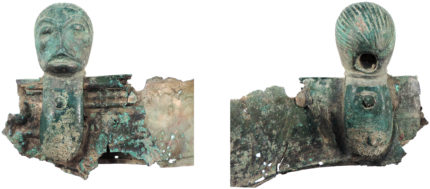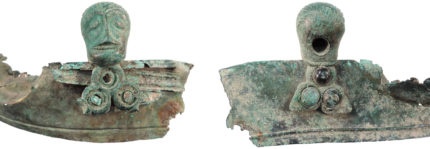 The remains of an Iron Age bucket discovered in Lenham, Kent, are a highlight of a record-setting 1,311 treasure finds (pdf) logged by the UK’s Portable Antiquities Scheme in 2019. Discovered by metal detectorist Rick Jones, the elaborate copper-alloy bucket fittings dates to around 50 B.C.; the bucket is part of a hoard with a copper alloy bowl and a clay pot, likely a grave assemblage for a high-status cremation burial.
The remains of an Iron Age bucket discovered in Lenham, Kent, are a highlight of a record-setting 1,311 treasure finds (pdf) logged by the UK’s Portable Antiquities Scheme in 2019. Discovered by metal detectorist Rick Jones, the elaborate copper-alloy bucket fittings dates to around 50 B.C.; the bucket is part of a hoard with a copper alloy bowl and a clay pot, likely a grave assemblage for a high-status cremation burial.
The bucket was made of wood which has rotted away, leaving the fittings behind. They are unusually decorated. The remains of the copper bands feature pairs of hippocampi (mythical creatures with the forelimbs and heads of horses and fish tails) facing each other. Between them is a four-legged animal on its back. Damage to the body and head make it difficult to identify the animal, but archaeologists think it may be a horse or a deer. Behind the left-facing hippocamp is a bird-like creature with a long hooked beak and sharp curved talons.
The bucket handles are even more ornate. The two fittings feature humanoid heads with large, wide-set eyes, eyebrow ridges that come together and go south to form the bridge of a nose, a wide mouth and combed back hair. Under the chin of one is a straight rectangle, a sort of elongated neck, with a rivet in the middle connecting it to the copper mount. Under the chin of the other is a pyramid of three balls.
The two faces are slightly different: one has dotted decoration along the mouth, brows, hairline and around the back of the neck, whilst the other is plainer with a slimmer jawline.
Close examination of the fittings helps us to understand how the bucket would have been used. The plainer mount appears more worn, and the attachment mechanism has also been repaired, with new holes pierced for reattachment. This was clearly a cherished and much-used object. Buckets like this are usually found in high-status cremation graves, several of which are known in Kent and on the near continent. They probably formed part of a drinking set, used for serving mead, wine or beer at feasts. Perhaps the people buried with these objects hosted such feasts in life, or maybe this was a way for the living to share the funeral feast with them.


